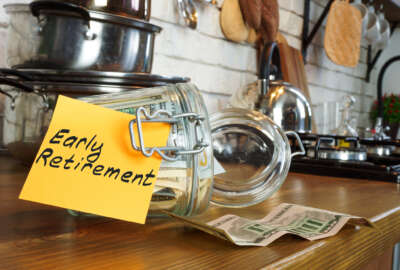DOJ employees detail ‘excruciating’ IVF costs, push for more FEHB coverage
FEHB carriers already cover some costs of IVF-related drugs. But employee testimonials show many feds still have to pay the “lion’s share” out of pocket.
With just a few days before the Office of Personnel Management wraps up 2025 negotiations with health carriers, a group of federal employees is making a final push for more fertility benefits through the Federal Employees Health Benefits (FEHB) program.
Dozens of federal employee testimonials, compiled by the employee advocacy organization Department of Justice Gender Equality Network (DOJ GEN), show the vast array of challenges individuals face while trying to build a family. The testimonials, coupled with a July 16 letter addressed to OPM Acting Director Rob Shriver, highlight what DOJ GEN said is a need for more extensive FEHB coverage of in vitro fertilization (IVF).
Many of the testimonials describe situations that occurred prior to OPM’s requirements in 2024 to expand IVF coverage through FEHB health plans. But Stacey Young, president of DOJ GEN, said even with the added benefits requirements, the remaining out of pocket costs can still present major financial challenges.
“Federal employees still need to pay for the lion’s share of IVF out of pocket, and that can be often impossible for employees to do,” Young said in an interview. “It’s an extremely expensive process.”
Some of the testimonials illustrate how costly the fertility treatments and medications can be. Some said they paid $30,000 or $40,000, while others said they spent up to $70,000 or even more.
Because of the high costs, Young described many of the collected stories as “excruciating.”
“Many went into debt, many had to borrow money from family, many are still paying it off,” Young said. “Some were unable to pay for it at all … and had to give up on trying to have children.”
Often due to the financial challenges, several of the DOJ employee testimonials described situations where an employee either left or thought about leaving a federal job to try to get better IVF coverage in the private sector or elsewhere.
“I’ve worked for DOJ for the better part of a decade, and I love my job, but I’ve considered leaving to work somewhere with fertility coverage,” wrote one employee, identified by the initials C.B. “Many law firms, companies and even some nonprofits cover fertility costs — including IVF — through either insurance coverage or an employer-issued fertility stipend. For the first time in my life, I have credit card debt — more than $20,000 — just because we want to have a family.”
For plan year 2024, OPM began requiring more IVF benefits from FEHB carriers. At a minimum, carriers must cover artificial insemination procedures and associated drugs, as well as the costs of IVF-related medications for three treatment cycles.
“Under the Biden-Harris administration, the federal government is proud to have promoted family building benefits for the past several years,” an OPM spokesperson said in a statement to Federal News Network.
But some federal benefits experts have said that despite the expansion for plan year 2024, the coverage requirements are still “fairly limited.” IVF treatments typically come with a price tag in the tens of thousands of dollars. And, in most cases, individuals need to undergo multiple cycles of treatments and medications, adding to the costs. IVF drugs account for about 35% of the overall IVF expenses.
A few DOJ employees describing more recent situations said OPM’s 2024 requirements for carriers have helped to some extent, but additional costs for IVF still pile up.
“While this eased some financial pressure, the funds were quickly exhausted due to ongoing costs for retrievals, transfers, embryo testing and medication,” DOJ employee Joshua Zimberg, whose family spent over $100,000 on IVF out of pocket, wrote in a testimonial.
Another DOJ employee, identified by the initials T.S., said they were at first “overjoyed” to learn of OPM’s fertility requirements for FEHB carriers that began earlier this year.
“However, we quickly realized that the limited benefits provided are not nearly enough to defray the substantial costs associated with even a single IVF cycle,” the employee wrote.
OPM said it has “strongly encouraged” carriers to offer more IVF coverage than the minimum requirements. For the current plan year, 24 carriers, accounting for the coverage of about one-third of FEHB enrollees, offer benefits beyond the minimum requirements, according to OPM.
Still, DOJ GEN, as well as many lawmakers, have been pushing for months for fuller fertility coverage through FEHB, urging OPM to require coverage of the costs of medications as well as treatments.
“These are federal employees who are still having real-world ramifications,” Abigail Farthing, a member of the DOJ GEN fertility benefits working group, said in an interview. “We need OPM to make sure these plans and carriers can help address some of the gaps we’re still seeing.”
But time is running short for OPM to hammer out what the FEHB carrier requirements will look like next year. OPM has a July 31 deadline to negotiate with carriers, and finalize rates and benefits for plan year 2025 ahead of Open Season this fall.
In late September, OPM will announce the final rates and benefits for the 2025 plan year. Open Season will run from Nov. 11 to Dec. 9 for benefits elections that will take effect for plan year 2025.
Copyright © 2025 Federal News Network. All rights reserved. This website is not intended for users located within the European Economic Area.
Drew Friedman is a workforce, pay and benefits reporter for Federal News Network.
Follow @dfriedmanWFED






